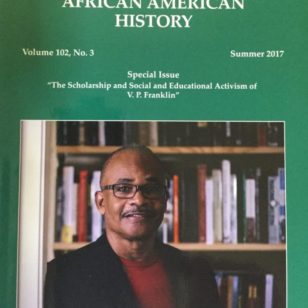
For the first time since Carter G. Woodson established Negro History Week in 1926, the Association for the Study of African American Life and History (ASALH) is no longer the publisher of the Journal of Negro History, now known as the Journal of African American History. From 1916 through 2017, the history magazine stood as the oldest black-published scholarly journal in the world. 101 years of tradition, of unquestioned excellence, over. Casting it aside, the ASALH board, under the leadership of Harvard’s Evelyn Brooks Higginbotham and with the concurrence of Editor VP Franklin signed a contract for the University of Chicago Press to publish the journal beginning in 2018. The erstwhile advocate of black self-determination, Franklin now labors under the management of the university where received his doctorate. ASALH prides itself on still owning the land that it now farms under the direction of white management.
None of this, of course, is right with Woodson. He fretted for the future of the Association and the journal. He imagined the journal would not always be published by the Association he founded. As if it were his personal property, he left a provision in his will that the journal cover bear his name as founder. He assumed that it would go to one of the black colleges and universities. Beating all odds, the journal remained independently published by the Association for sixty-seven years after his death. Moreover, for the last decade, it became profitable and remained so when the decision was made to give up publishing it. Not only did it pay the editor a modest stipend, it pulled the equivalent of an extra employee through the Great Recession. Indeed, it was the reason that the Association never had to lay anyone off as many did. Indeed, the Association moves under white management at a financial disadvantage. The Association will make less than it did on its own last year and what it was projected to make in 2018.
How did this happen? What plagues ASALH afflicts many black organizations nowadays. People with little experience and financial ability want to leave their mark, and they do so in a manner that flies in the face of sound stewardship. Initially laboring under the illusion that the move would be more profitable, the president told the members of ASALH in the 2016 Business Session that ASALH would have the money pay for many of the things that ASALH needs. As this blog has shown that was a mirage born of a lack of due diligence, and they had every reason to know better. When confronted about the revenue loss, the treasurer, Gilbert Smith, said there was other money that ASALH could attract. Perhaps, but before the first issue of the University of Chicago Press journal could be printed, ASALH had to borrow money from Chicago for fear of not being able to pay its bill. Let us hope we do not look up one Black History Month and discover that ASALH has had to close its doors under such stewardship. Were Woodson still alive perhaps he would add a chapter to The Mis-Education of the Negro.
Let us hope better for the Journal of Negro Education, founded in 1932 by Charles H. Thompson. It is now the oldest scholarly journal published by black people in the world.




